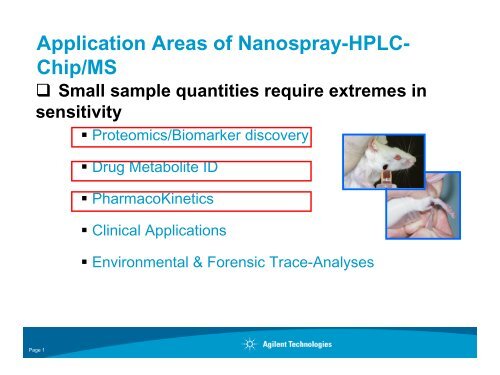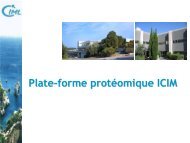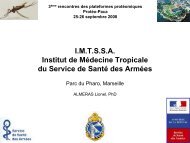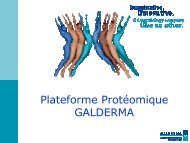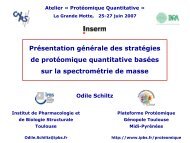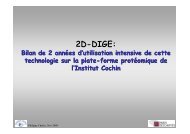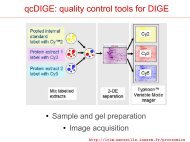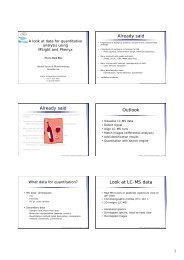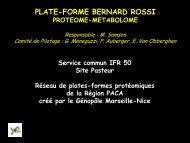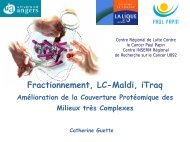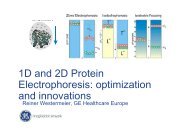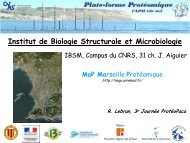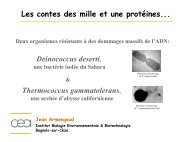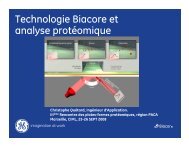Application Areas of Nanospray-HPLC- Chip/MS
Application Areas of Nanospray-HPLC- Chip/MS
Application Areas of Nanospray-HPLC- Chip/MS
Create successful ePaper yourself
Turn your PDF publications into a flip-book with our unique Google optimized e-Paper software.
<strong>Application</strong> <strong>Areas</strong> <strong>of</strong> <strong>Nanospray</strong>-<strong>HPLC</strong>-<br />
<strong>Chip</strong>/<strong>MS</strong><br />
Small sample quantities require extremes in<br />
sensitivity<br />
Page 1<br />
Proteomics/Biomarker discovery<br />
Drug Metabolite ID<br />
PharmacoKinetics<br />
Clinical <strong>Application</strong>s<br />
Environmental & Forensic Trace-Analyses
Sensitivity by <strong>Nanospray</strong> and Reduction<br />
<strong>of</strong> ID<br />
Page 2<br />
2r = 4.6mm<br />
2r =<br />
1.5mm<br />
V<br />
@ constant<br />
linear velocity<br />
L<br />
V sp<br />
sp<br />
=<br />
r π<br />
2<br />
L<br />
<strong>Chip</strong>: Analytical column = 0.075mm ID<br />
Intensitiy = f(<br />
c)<br />
=<br />
L<br />
x10<br />
L<br />
m<br />
V sp
Page 3<br />
Typical set-up <strong>of</strong> Nano-Spray LC/<strong>MS</strong><br />
• Sensitivity<br />
75µm ID analytical column<br />
Challenging to set-up & maintain<br />
• Multiple parts<br />
Possible leaks<br />
Possible misalignments<br />
• Robustness & ease-<strong>of</strong>-use<br />
System<br />
Valve<br />
Enrichment<br />
Frequent clogging <strong>of</strong> spray needle<br />
After part replacement system can take hours to stabilize<br />
Chromatographic degradation<br />
• Extra column volume<br />
Diffusion leads to band broadening<br />
Tubings<br />
Spray tip<br />
Nano column<br />
Fittings
Page 4<br />
Advantages <strong>of</strong> <strong>HPLC</strong>-<strong>Chip</strong> Nano-<br />
• Sensitivity<br />
75µm ID analytical column<br />
• Multiple parts integrated on <strong>Chip</strong><br />
Leaks<br />
Misalignments<br />
• Robustness & ease-<strong>of</strong>-use<br />
Analysis reproducibility<br />
Clogging <strong>of</strong> spray needle<br />
Plug-&-Play device<br />
Converts sophisticated analysis to simple operation (multi-D)<br />
• Extra column volume<br />
Chromatographic performance<br />
LC/<strong>MS</strong><br />
! LC-<strong>Chip</strong> Suitability for Routine Environment !
Page 5<br />
Ready-to-use in 4 steps<br />
1 2<br />
3<br />
Set up method<br />
Insert <strong>Chip</strong><br />
Click<br />
1200 Nano <strong>HPLC</strong> <strong>Chip</strong> Cube on QTOF Mass Hunter<br />
s<strong>of</strong>tware<br />
4<br />
<strong>Chip</strong> automatically moves<br />
into spray position<br />
<strong>MS</strong><br />
<strong>Chip</strong> Tip<br />
Spray<br />
Camera visualises<br />
nanospray
Automated <strong>HPLC</strong>-<strong>Chip</strong> Workflow<br />
Page 6<br />
Stator<br />
Rotor<br />
Sixport valve<br />
Autosampler<br />
Waste<br />
TC<br />
All components chip-integrated<br />
extra column volume<br />
chromatographic performance<br />
Production by laser ablation<br />
leaks<br />
misalignments<br />
Nano pump<br />
Nano analytical column<br />
<strong>Nanospray</strong> tip
Page 7<br />
Online Workflow<br />
Stator<br />
Rotor<br />
Enrichment<br />
Analysis<br />
Rotor<br />
Switch
<strong>Nanospray</strong><br />
99.5% H 2 O 90% H 2 O 65% H 2 O 10% H 2 O<br />
Page 8<br />
99 H 2 O<br />
Data courtesy <strong>of</strong> Paul Goodley, Agilent Technologies<br />
(USA)<br />
99<br />
ACN<br />
---EIC m/z 433 +3 Angiotensin I<br />
---EIC m/z 450-640 Noise Measurements<br />
Use <strong>of</strong> the<br />
orthogonal dual<br />
electrode<br />
nanospray ion<br />
source shows<br />
constant signal-tonoise<br />
for all types <strong>of</strong><br />
Taylor cone plumes<br />
when combined<br />
with the polymer<br />
chip<br />
Flow: 320nl/min V: 2100volts<br />
Angiotensin infused at constant flow rate over the 50 min<br />
gradient.<br />
•<strong>HPLC</strong>-<strong>Chip</strong> delivers robust spray performance for all solvent conditions.<br />
•Does not require voltage change or optimization during a gradient.<br />
•Polyimide nanospray emitter lifetime measured in weeks!
Page 9<br />
<strong>HPLC</strong>-<strong>Chip</strong>/<strong>MS</strong>: Features and<br />
Benefits<br />
• High sensitivity & chromatographic performance<br />
• Improved <strong>MS</strong>/<strong>MS</strong> data quality<br />
• Easy to use, robust, plug-&-play device suitable for<br />
unattended routine identification and quantification<br />
• Automated <strong>Chip</strong>-system for sample enrichment, separation &<br />
nebulization now into all Agilent mass spectrometers<br />
<strong>Chip</strong> – Ion Trap<br />
• <strong>MS</strong> & <strong>MS</strong> n<br />
<strong>Chip</strong> – TOF<br />
• <strong>MS</strong> (<strong>MS</strong> 2 )<br />
• Accurate mass<br />
<strong>Chip</strong> – QTOF<br />
• <strong>MS</strong> & <strong>MS</strong> 2<br />
• Accurate mass<br />
<strong>Chip</strong> – QQQ<br />
• <strong>MS</strong> & <strong>MS</strong> 2<br />
• Quantitation
Ultra High Capacity (UHC)-SM-<strong>Chip</strong><br />
Main Objective<br />
Page 10<br />
Enrichment <strong>of</strong> small molecules comprising a wide range <strong>of</strong> polarities<br />
500nL enrichment<br />
column<br />
6<br />
5<br />
1<br />
2<br />
4<br />
3<br />
Separation Column 150mm x 75µm<br />
ID
The Consequences – The “TOF/QTOF Image”<br />
• limited dynamic range (2 decades)<br />
• quantification is difficult if not impossible<br />
• mass accuracy varies with signal level. „Exact mass“ requires<br />
highly experienced operator.<br />
• high resolution can be achieved only by extending the ion<br />
path length, sacrificing signal abundance.<br />
Page 11
Page 12<br />
Traditional Signal Processing Using TDC<br />
LOW ion current<br />
situation<br />
TDC<br />
threshold<br />
Flight time: 50.000000 µsec<br />
1. A single ion hits the detector.<br />
When exceeding the intensity threshold, the flight time<br />
gets measured.<br />
1a. During the subsequent transient a second ion hits<br />
the detector. Within the instrument’s resolution we<br />
register a slightly shifted flight time.<br />
TDC = Time to Digital Converter
TDC Principle (contd.)<br />
Page 13<br />
HIGH ion current<br />
situation<br />
TDC<br />
threshold<br />
Flight time:<br />
Now the sample is more concentrated, causing<br />
two ions reaching the detector at almost the same<br />
time (within the instrument’s resolution). The dark<br />
blue curve would represent the resulting signal.<br />
Unfortunately, the TDC only registers the first<br />
arriving ion exceeding the threshold. The clock<br />
cannot be reset fast enough to register the<br />
second ion arriving a little later. This mistakenly<br />
shifts the flight times to shorter values with<br />
increasing signal levels.<br />
In order to compensate for this weakness, TDC<br />
based systems apply ”dead time correction“<br />
factors and/or ion beam attenuation at high signal<br />
levels.
TDC Principle (contd.)<br />
Page 14<br />
HIGH ion current<br />
situation<br />
TDC<br />
threshold<br />
Flight time:<br />
Now the sample is more concentrated, causing<br />
two ions reaching the detector at almost the same<br />
time (within the instrument’s resolution). The dark<br />
blue curve would represent the resulting signal.<br />
Unfortunately, the TDC only registers the first<br />
arriving ion exceeding the threshold. The clock<br />
cannot be reset fast enough to register the<br />
second ion arriving a little later. This mistakenly<br />
shifts the flight times to shorter values with<br />
increasing signal levels.<br />
In order to compensate for this weakness, TDC<br />
based systems apply ”dead time correction“<br />
factors and/or ion beam attenuation at high signal<br />
levels.
Modern Signal Processing Using ADC<br />
Page 15<br />
LOW and HIGH<br />
ion current<br />
situation<br />
Flight time: is represented by the centroid across all ions<br />
1. A single ion hits the detector.<br />
The apex <strong>of</strong> the resulting signal gets registered<br />
as the arrival time.<br />
2. Now the sample is more concentrated, causing<br />
two (or up to 256 due to 8 bit ADC) ions reaching<br />
the detector within minimal time shifts (according<br />
to the TOF’s resolution). The dark blue curve<br />
represents the resulting signal.<br />
As described earlier, TDC systems would have<br />
problems to digitize the overall arrival time<br />
correctly.<br />
3. ADC based systems transform the abundance <strong>of</strong><br />
the resulting signal in time increments <strong>of</strong> 1 nsec<br />
(1 GHz ADC), 500 psec (2 GHz ADC) or 250 psec<br />
(4 GHz ADC). No “dead time correction” or<br />
attenuation <strong>of</strong> the ion beam required.<br />
ADC = Analog to Digital Converter
Enhancements in Time-<strong>of</strong>-Flight<br />
New Acquisition Technology Increasing Resolving Power<br />
O<br />
FIA, 2 scans/sec (6713 transients/scan)<br />
2 IRM averaged over five scans<br />
Page 16<br />
O<br />
O<br />
OH<br />
Butyl paraben<br />
[M+H] + 195.10157<br />
Methyl 5-acetylsalicylate<br />
[M+H] + 195.06519<br />
HO<br />
O<br />
8 bit – 1 GHz<br />
Analog Digital<br />
Converter<br />
O<br />
195.088679<br />
6,100 Resolving<br />
Power (FWHM)<br />
195 195.02 195.04 195.06 195.08 195.1 195.12 195.14 195.16 195.18 195.2<br />
Counts vs. Mass-to-Charge (m/z)
Enhancements in Time-<strong>of</strong>-Flight<br />
New Acquisition Technology Increasing Resolving Power<br />
O<br />
FIA, 2 scans/sec (6713 transients/scan)<br />
2 IRM averaged over five scans<br />
Page 17<br />
O<br />
O<br />
OH<br />
Butyl paraben<br />
[M+H] + 195.10157<br />
Methyl 5-acetylsalicylate<br />
[M+H] + 195.06519<br />
HO<br />
O<br />
8 bit – 4 GHz<br />
Analog Digital<br />
Converter<br />
Transient Peak<br />
Picking<br />
O<br />
+ 0.8 ppm<br />
195.065349<br />
195.101392<br />
0.036 Da<br />
- 0.9 ppm<br />
14,000 Resolving<br />
Power (FWHM)<br />
195 195.02 195.04 195.06 195.08 195.1 195.12 195.14 195.16 195.18 195.2<br />
Counts vs. Mass-to-Charge (m/z)
New 4GHz Acquisition System<br />
up to 5 Decades <strong>of</strong> In-Spectrum Dynamic Range<br />
Max Abd<br />
3x10 7<br />
Page 18<br />
x10 6<br />
9<br />
8.8<br />
8.6<br />
8.4<br />
8.2<br />
8<br />
7.8<br />
7.6<br />
7.4<br />
7.2<br />
7<br />
6.8<br />
6.6<br />
6.4<br />
6.2<br />
6<br />
5.8<br />
5.6<br />
5.4<br />
5.2<br />
5<br />
4.8<br />
4.6<br />
4.4<br />
4.2<br />
4<br />
3.8<br />
3.6<br />
3.4<br />
3.2<br />
3<br />
2.8<br />
2.6<br />
2.4<br />
2.2<br />
2<br />
1.8<br />
1.6<br />
1.4<br />
1.2<br />
1<br />
0.8<br />
0.6<br />
0.4<br />
0.2<br />
0<br />
+ Scan (# 31-35, 5 scans) niacinamide_erythromycin.d<br />
* 123.055394<br />
9x10 6 cts<br />
Niacinamide, 10 ng/µL<br />
[M+H] + = 123.055289 m/z<br />
Error = +0.8 ppm<br />
In-Scan Dynamic Range<br />
This Example<br />
9x10 6 / 250 = 3.6 × 10 4<br />
Maximum<br />
3x10 7 / 250 = 1.2x 10 5<br />
250 cts<br />
207.007866 329.056151 425.138434<br />
659.287715 759.355249 922.009798<br />
1221.991581<br />
1521.971969<br />
100 150 200 250 300 350 400 450 500 550 600 650 700 750 800 850 900 950 1000 1050 1100 1150 1200 1250 1300 1350 1400 1450 1500 1550 1600 1650 1700<br />
Counts vs. Mass-to-Charge (m/ z)<br />
x10 2<br />
2.5<br />
2.4<br />
2.3<br />
2.2<br />
2.1<br />
2<br />
1.9<br />
1.8<br />
1.7<br />
1.6<br />
1.5<br />
1.4<br />
1.3<br />
1.2<br />
1.1<br />
1<br />
0.9<br />
0.8<br />
0.7<br />
0.6<br />
0.5<br />
0.4<br />
0.3<br />
0.2<br />
0.1<br />
0<br />
+ Scan (# 31-35, 5 scans) niacinamide_erythromycin.d<br />
734.468956<br />
Erythromycin, 500 fg/µL<br />
[M+H] + = 734.468518 m/z<br />
Error = +0.6 ppm<br />
735.416113<br />
736.387755<br />
734 734.5 735 735.5 736 736.5 737 737.5 738 738.5 739 739.5 740 740.5<br />
Counts vs. Mass-to-Charge (m/ z)
TIC <strong>of</strong> A Mixture<br />
Page 19<br />
x10 8<br />
1.5<br />
1.4<br />
1.3<br />
1.2<br />
1.1<br />
1<br />
0.9<br />
0.8<br />
0.7<br />
0.6<br />
0.5<br />
0.4<br />
0.3<br />
0.2<br />
0.1<br />
+ TIC Scan mix995.d<br />
1<br />
Flow Injection<br />
Angiotensin (m/z 1046): 16 nM<br />
Caffeine (m/z 195): 25 nM<br />
Reserpine (m/z 609): 25 µM<br />
0 0.1 0.2 0.3 0.4 0.5 0.6 0.7 0.8 0.9 1 1.1 1.2 1.3 1.4 1.5 1.6 1.7 1.8 1.9 2 2.1 2.2 2.3<br />
Counts vs. Acquisition Time (min)<br />
Important: 1) Mixture<br />
2) Co-Elution<br />
3) Wide [ ] Range<br />
4) Wide m/z Range<br />
An artificial sample,<br />
but representative<br />
<strong>of</strong> real-world<br />
complex sample<br />
analysis with matrix
Page 20<br />
Flight Tube Thermal Stability<br />
Vacuum Insulated<br />
Flight Tube<br />
Thermostatted<br />
HV Power Supplies<br />
Low CTE* Inner<br />
Flight Tube (INVAR)<br />
* Coefficient <strong>of</strong> Thermal Expansion
Mass Accuracy – Environmental Extremes<br />
Page 21<br />
Injecting every 15 minutes, from 11º - 36º C and 10 - 95 %Relative Humidity<br />
Mass Error, ppm<br />
5<br />
4<br />
3<br />
2<br />
1<br />
0<br />
-1<br />
-2<br />
-3<br />
-4<br />
-5<br />
Mass Accuracy<br />
0 50 100 150 200 250 300<br />
Reserpine Injection
Conclusion<br />
Sensitivity<br />
no loss, as ion path remains unchanged<br />
Resolution<br />
2x to 3x increase by signal processing<br />
Mass accuracy<br />
sub-2 ppm with IRM, sub-5 ppm without IRM<br />
Dynamic range<br />
up to 5 decades by dual-channel signal amplifier/logic<br />
Page 22
Page 23<br />
Merci pour votre<br />
attention,<br />
Questions?<br />
Frederic_metral@agilent.com<br />
Tel:06 78 73 55 26


